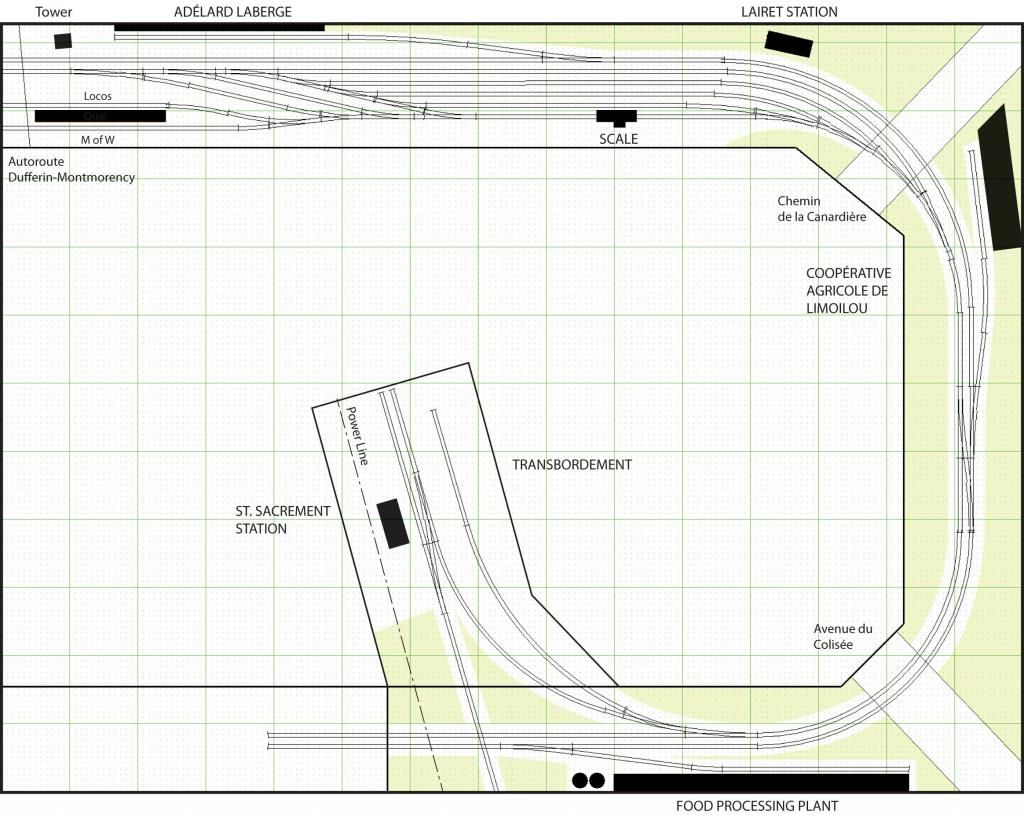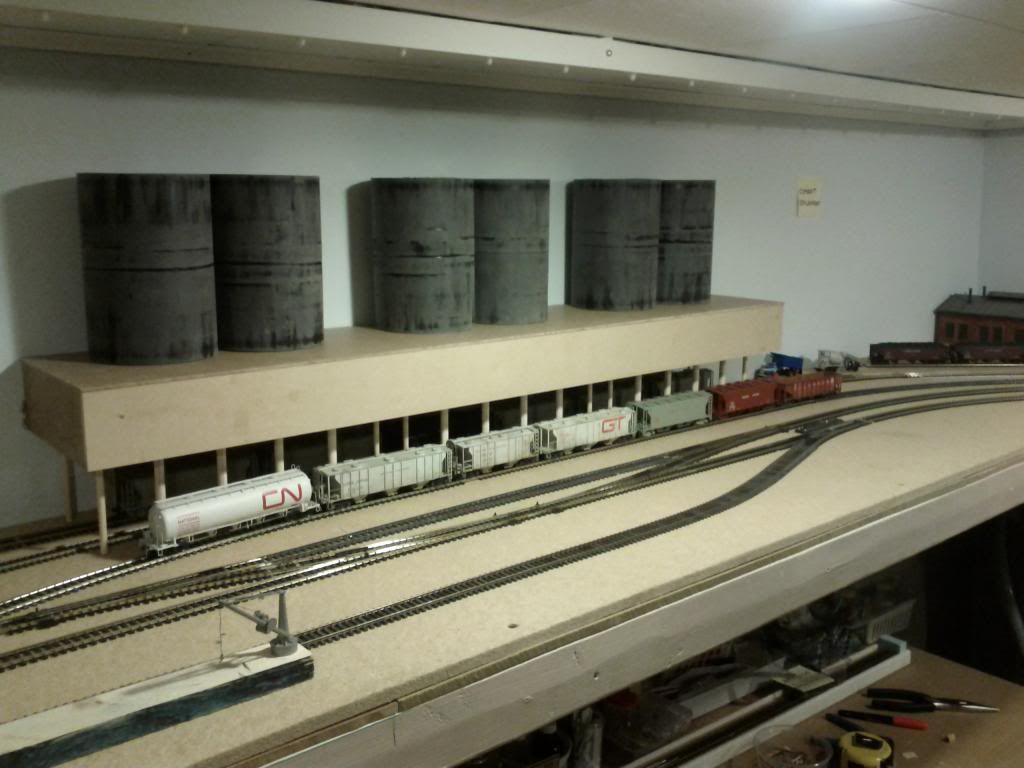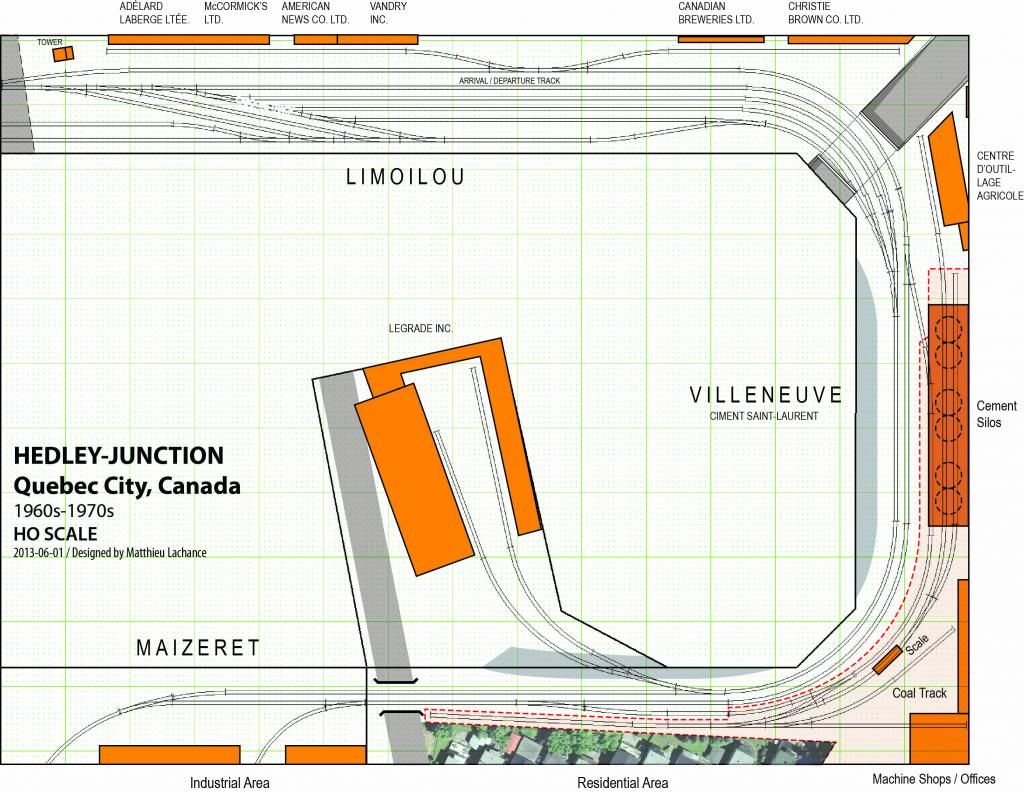The layout
design is now more than 3 years old. Many concepts, ideas and revolutions took
place since the first run, but I’m quite pleased by the fact my original design
still stands its ground so far. At least, I like to believe it…
I remember
when I planned it all back in early 2010. At that time, I was playing avidly
OpenTTD, a classic 90s computer game about transportation. It was a revelation
because before playing that game, I only focussed my model railroading in
replicating what I saw. How trains looked was important but I gave little thought
about how they operated.
OpenTTD
isn’t the paragon of realistic operation, but at least, it’s rational. At some
point, my rail network grew beyond my limited knowledge of railway managing. What
a mess it was! It took me hours to learn about signals, orders and many other
neglected aspects. Soon, stations and yards grew in size but also became more effective
and fun to run. Mainlines, branchlines and sidings now had a purpose. Better,
the invested money started to pay off. Want a thrill to see these hundred
trains running through the land, delivering goods in a timely manner. To me it
all became clear: operation was fun! So much fun it was also a food for
thoughts instead of a cosmetic hobby like other modelling. This game sparked my
renewed interest in model railroading big time. Lessons learned virtually had
to be applied to the “real” modelling world… I was ready for a challenge and
Hedley-Junction layout was soon to be born.
Small but
effective, the new layout was built around a desired flow of operation inspired
by the minimalist CN Lairet Subdivision in downtown Quebec City. Tracks needed
were identified, their role defined and relation between them established. From
that sketch of interactions a new yard – Limoilou – was born. A small yard I’m
still proud of after many operation sessions. A yard that survived all makeover
schemes since then. I could hardly add a new track; I could hardly remove a
single track. It’s not perfect, but to be honest, it perfectly fills in the
role it has been designed and built for. It’s all about pertinence!
On the
other hand, I had quite a hard time settling on an efficient pattern of
industries. Honestly, too much ideas, too little place… Or to be exact: too
much conflicting ideas for a given place. I was afraid to make things clean and
logical like the yard. I went for the anecdote instead of brushing an overall
operating scheme. And you know what? I knew all about it from the start… but
couldn’t accept the cold hard facts. Man, we like to fill up every little empty
space! Almost a phobia!
Earlier
this year, a big ill-conceived cement plant found its place on the layout.
Track design was realistic and well-done but the structure couldn’t fit the
available space. It became quickly a parody of itself. No wonder it was
dismantled as soon as it was built.
Finally, in
a recent realistic operation session, I found out switching about 30 feet of
mainline was taking almost 3 hours. Enough to tire any operator I know. It was
clear, we had to make room for something new and start thinking all over.
The savior
was a small 14-miles railway in Joliette, QC called Chemin de fer de
Lanaudière. Utterly minimal, it was everything but plain. Operation made sense,
switching industries called for simple but interesting moves and interchange
with Class I railways made it feel larger that really was. I was convinced
Hedley-Junction had to disappear and quickly studied the new prototype. Soon a
new streamlined layout plan was born. I can’t say my fellow club members were
enthusiastic, but they recognized it had its strong points. We knew we had to
do something, but we had to step aside for a while. It was decided we would
take a break for model railroading, as long as needed. Talk about a smart move!
Then a few
weeks ago, club resumed its activities. First of all, we evaluated the layout
features coldly. Good designs would be kept as they are or improved, other
unsatisfying area would be modified to suit our needs. Funny as it can be, we
found out most of the layout was good enough to survive. But Hedley-Junction
industrial district was identified as a real let-down in term of appeal and
operation. We particularly discussed the small peninsula future. I was
convinced it had to go, but Jerome and Louis-Marie had a different opinion.
My
Lanaudière layout plan used it to create an interchange point with a diamond
and that caught their imagination. Jerome always advocated we should represent
Allenby, a busy CPR-CNR crossing in Quebec City. The peninsula was good enough
to make it happens following the Lanaudière proposal. It’s no exaggeration to
say this was the layout turning point. It was now possible to envision the
entire rail network before us and select pertinent features over anecdotes.
 |
| The actual updated track plan - "Less is more" |
The result
was a stunningly streamlined but realistic track plan. Over 50% of available
area is now pure mainline running in a suburban Limoilou’s neighbourhood. Most
scenery is focussed toward a realistic depiction of track roadbed and we now
have a real interchange point with CPR. This gives the layout a real
destination for its trains and a great photogenic spots for Multimark CP Rail
MLW fleet!
BTW, track will soon be upgraded with PECO code 83 turnouts. We particularly appreciate how easy to operate PECO turnouts are. They are fairly nice to look at and no need for complicated and costly operating devices. Most turnouts on mainline will be #8. Yard will be made out of curved #7 and straight #6 turnouts. Minimal radius is 36 inches, maximum is 44 inches. Why? Because it's more realistic, but mainly because operation is easier. Having a yard on a curve can only works if you have no coupling issues. Also, I wish my U-2-g can travel again the rail without causing shorts. Anyway, with less track you have more place to use longer and better looking turnouts for smoother operation.
BTW, track will soon be upgraded with PECO code 83 turnouts. We particularly appreciate how easy to operate PECO turnouts are. They are fairly nice to look at and no need for complicated and costly operating devices. Most turnouts on mainline will be #8. Yard will be made out of curved #7 and straight #6 turnouts. Minimal radius is 36 inches, maximum is 44 inches. Why? Because it's more realistic, but mainly because operation is easier. Having a yard on a curve can only works if you have no coupling issues. Also, I wish my U-2-g can travel again the rail without causing shorts. Anyway, with less track you have more place to use longer and better looking turnouts for smoother operation.


No comments:
Post a Comment